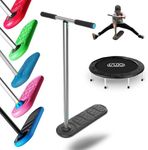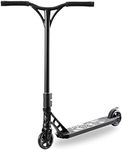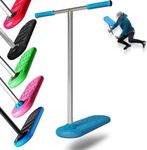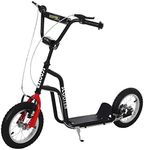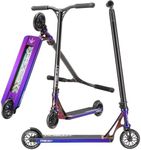Buying Guide for the Best Kids Stunt Scooters
Choosing the right stunt scooter for your child can be a fun and rewarding experience. Stunt scooters are designed for tricks and stunts, so they need to be durable and safe. When selecting a scooter, consider your child's age, skill level, and the type of stunts they want to perform. It's important to find a balance between a scooter that is lightweight for easy maneuverability and one that is sturdy enough to withstand the impact of tricks. Always prioritize safety features and ensure the scooter is appropriate for your child's size and weight.Deck SizeThe deck is the part of the scooter where the rider stands. Deck size is important because it affects balance and control. A wider deck offers more stability, which is great for beginners, while a narrower deck allows for more agility, which is preferred by more experienced riders. For younger children or beginners, a deck that is around 4-5 inches wide is suitable. As the rider becomes more skilled, they might prefer a narrower deck for more advanced tricks.
Handlebar HeightThe handlebar height is crucial for comfort and control. It should ideally be around waist height when the rider is standing on the deck. If the handlebars are too high or too low, it can affect the rider's ability to perform tricks and maintain balance. For younger children, adjustable handlebars can be a good option as they allow the scooter to grow with the child. Always ensure the handlebars are secure and comfortable for the rider's grip.
Wheel SizeWheel size affects the scooter's speed and smoothness of ride. Smaller wheels, typically around 100mm, are lighter and allow for quicker tricks, making them ideal for skate parks. Larger wheels, around 110mm or more, provide a smoother ride and are better for street riding. Consider where your child will be using the scooter most often to determine the best wheel size. For beginners, starting with smaller wheels can help them learn tricks more easily.
WeightThe weight of the scooter is important for maneuverability and ease of use. A lighter scooter is easier for a child to handle and perform tricks with, but it should still be sturdy enough to withstand impacts. For younger or smaller children, a lightweight scooter is ideal. As the child grows and becomes more skilled, they might prefer a slightly heavier scooter that offers more stability during advanced tricks.
MaterialThe material of the scooter affects its durability and weight. Most stunt scooters are made from aluminum, which is lightweight and strong, making it ideal for performing tricks. Some scooters may have steel components for added strength, but this can make them heavier. Consider the balance between weight and durability based on your child's skill level and the type of stunts they want to perform. For beginners, a fully aluminum scooter is often sufficient.
Compression SystemThe compression system is a mechanism that keeps the scooter's headset and fork tightly connected, which is crucial for smooth steering and stability. There are different types of compression systems, such as IHC, HIC, and SCS, each offering varying levels of performance and maintenance. For beginners, a simple and easy-to-maintain system like IHC is often recommended. As the rider becomes more advanced, they might prefer a more robust system like SCS for better performance during complex tricks.
